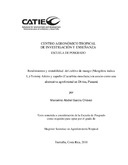| dc.description.abstract | finding that coverage of mango had a significant effect on pumpkin yield. In financial terMON, the monoculture mango had a higher profitability than associated and monoculture pumpkin, no considering the effects on soil and environment in general. Even it was found that these associations are not profitable after three years of mango establishment there are others positive effects to determinate on mid and long term. El trabajo se desarrolló en terrenos del Instituto Nacional de Agricultura (INA) en Cañazas, provincia de Veraguas, Panamá situada geográficamente entre 08{eth} 08’ 47†de latitud norte 42{eth} 34' longitud oeste. El sitio donde se ubicó la investigación presenta suelos arables y no arables. En la parte central los suelos son arables de tipo II, III y IV aptos para desarrollar actividades productivas.Para el mango se obtuvo una Producción de 6,9 t ha-1 de mango en el testigo podado y de 7,5 t ha-1 en el testigo sin poda, mientras que la mayor cantidad de frutos se logró en el asocio del mango sin poda con el cultivo de zapallo con una densidad de 1x8 con 341 frutos árbol-1. Por otra parte, con el zapallo los mayores rendimientos (24,1 t ha-1 y 10,3 t ha-1) se alcanzaron en el testigo con la densidad de 1x4 en el testigo de 1x8 respectivamente, encontrando que la cobertura del mango tuvo un efecto significativo sobre el rendimiento del zapallo. En términos financieros el monocultivo de mango obtuvo una mayor rentabilidad que el asocio y el monocultivo de zapallo, sin considerar los efectos en el suelo y ambiente en general. Aunque resultó que el asocio no es rentable después del los tres años de establecido el cultivo de mango, hay otros efectos positivos que hay determinar a mediano y largo plazo. This work was developed on lands belonging to the Agricultural National Institute (INA) on Cañazas, Veraguas Province, Panama geographically located between 08° 08’47’’ North Latitude and 42°34’ West Longitude. The site where research was carried out has arable and non-arable soils. In the central part, soils are arable type II, III and IV suitable to develop productive activities. For mango, it was obtained a 6.9 t ha-1 of mango production at pruned control and 7.5 t ha-1 at non-pruned control, while the highest number of fruit was obtained from association between non-pruned mango and pumpkin with 1x8 m density presenting 341 fruit tree-1. In other hand, the pumpkin highest yields (24,1 t ha-1 and 10,3 ha-1) was obtained from 1x4 and 1x8 densities control pumpkins plots respectively | es_ES |


